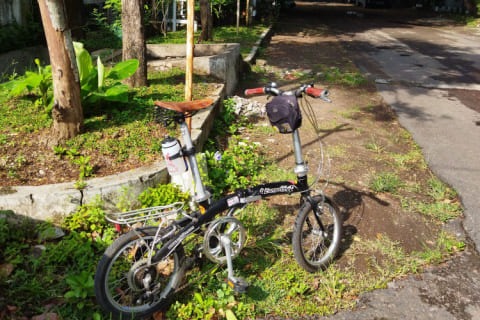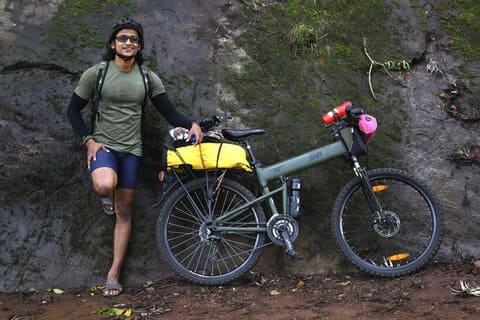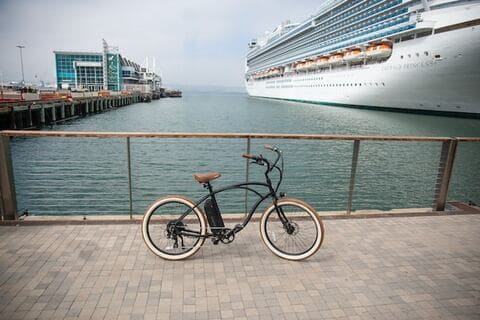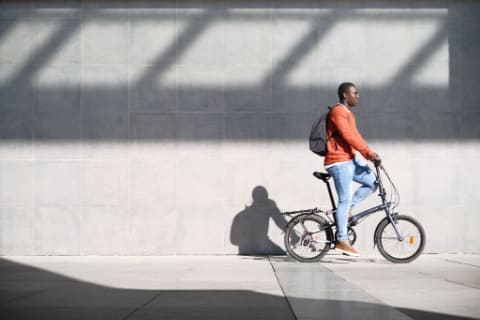Folding bikes are primarily known for their use in urban environments. They are tailor-made for city streets. But what if you were searching for something more adventurous? How will they fare if you decide to take them into a more rugged off-road environment?
Regular folding bikes can be used in a limited number of off-road conditions. They can cope with gravel, grass, cobblestones, and towpaths. But they won’t be able to handle rough dirt tracks with obstacles like rocks or tree roots. Foldable mountain bikes are best for these circumstances.

For a regular folding bike, you must be careful about where you use it.
If it gets too rough, most folding bikes will struggle. Read on to learn when a folding bike can be used for off-roading and when it should be avoided.
Are Folding Bikes Good For Road And Mountain Biking?
The majority of folding bikes aren’t built to handle off-road conditions because they don’t have a suspension system, the folding hinges on the frame are not designed to withstand serious force, and the smaller wheels are harder to roll over larger obstacles.
First, they don’t have a suspension system.
This means that the rider will feel every impact on the path. When you head into dirt tracks with large rocks and holes to navigate through, this can quickly become an unpleasant experience.

Next, you need to consider the frame.
When serious force is applied, like repeatedly jumping off rocks or ramps, it might snap along the folding hinges. While this is rare, if this occurs, your bike will need to be replaced.
Third, they tend to have smaller wheels.
Because of this, it will be harder to roll over larger obstacles, like rocks or roots. The tread might not give you enough grip on slippery surfaces, like traveling over mud. Furthermore, ground clearance will be limited. Plus, smaller wheels won’t be able to absorb the impact from bumps in the wheel.
These issues will become more pronounced when examining a folding road bike.
Because of the thin wheels, it’s recommended that you avoid all types of off-road tracks. This includes gravel and towpaths.
Even cobblestone streets can cause some problems.
What Conditions Can A Folding Bike Be Used In?
Ideally, it would help if you stuck to a paved road surface when riding a folding bike. But this won’t always be possible. If you need to, there are a few circumstances where a regular folding bike can be used without too many issues:
- Gravel tracks
- Grass
- Cobblestones
- Towpaths
- Logging paths
But there are a few things to keep in mind when riding over this type of terrain:
- Slow down. Your bike might not have enough tread on the tires to deal with loose gravel, so you might notice yourself sliding around a little more. By slowing down, you can ensure that you stay in control.
- Absorbing the bumps. In most cases, you won’t have any suspension on a folding bike. But you can stand up on the pedals and use your knees and elbows to help you absorb any minor impacts on the road.
- Customizing the bike. If you plan on regularly riding through these rougher sections, you might want to consider tires that provide more clearance or tread. Though, depending on the type of bike you have, this type of modification won’t always be possible. You can visit a local bike shop to see if they can suggest any solutions.
- Keep it clean. When you head off-road, you will often find that dirt can find its way onto the tires and into the chain. At the end of your trip, you should take a little time to remove this by following the instructions in this guide. If you don’t, you will experience more wear and tear, forcing you to repair components more frequently.
Using A Folding Mountain Bike for Off-Road Riding
A few folding bikes have been designed to deal with the rigors of tracking on dirt tracks. These are folding mountain bikes. There are a few elements that help to set them apart from a regular folding bike:
- Larger wheels. The exact wheel size will depend on the model that you select. In most cases, they will be between 24 and 26 inches. Though some can be up to 28 inches. This will give riders more control and make overcoming obstacles like rocks easier.
- Suspension. There are a few types of suspension setups to explore. Some models will only have suspension in the front tires. This will be suitable for those who want to try milder dirt trails. You can also find folding mountain bikes with shock absorbers on the front and rear tires. These are best for harsher trails with plenty of big rocks and jumps.
- More responsive brakes. Riders need more control when traveling along dirt tracks, with the ability to stop suddenly if an obstacle blocks the path. Plus, a robust braking system will allow riders to make tight turns on a winding path.
- Stronger frame. These types of bikes have been designed to deal with bumps.
- Slightly heavier. The hardier construction of mountain folding bikes comes at a price. They will be a little heavier than a regular mountain bike. Some models can be up to 34 pounds. The larger wheels also tend to make them a little bigger when folded. But you shouldn’t have any problems fitting a folding mountain bike in the back of your car.
- More gears. It’s typical for folding mountain bikes to come with around 24 gears, compared to seven or nine on a regular folding bike. This gives riders more options when heading up a steep hill.
- More expensive. A folding mountain bike will be significantly more costly than a regular folding bike. For comparison, a commuter bike will start at around $300. The mountain bike variety will begin at about $1,250. Plus, these aren’t as common as commuter bikes so you might have fewer choices available.
It should be noted that you can get some folding bikes designed for riding on the beach. These bikes are known for their fatter tires. This provides more traction on the sandy surface.
Folding mountain bikes will be able to cope with most dirt trails.
They can hold their own on muddy ground and won’t be phased by rocky ground or jumps. You also don’t need to worry about them getting wet or dirty. Most models will have performance that is on par with a conventional mountain bike.
Though, it would help if you cleaned them after your adventure to stop the gears and folding mechanism from getting clogged with mud.
The only thing you need to bear in mind is the weight capacity limit.
If you exceed this, the strain on the frame will increase, raising the risk of breakage. Most foldable mountain bikes can carry 250 to 300 pounds, but it’s best to double-check with the owner’s manual before you start riding.
Final Thoughts
Regular folding bikes are ideal for the daily commute. Just because they can take on some limited off-road conditions, like gravel or towpaths, doesn’t mean it’s a good idea.
The smaller tires won’t have enough traction, and you’ll feel every bump in the road due to the lack of suspension. Even worse, there is a risk that the bike frame will snap under stress, leaving you with an expensive repair.
Instead, it’s best to use a foldable mountain bike.
These will be ideal for rougher rides along dirt tracks. They won’t have problems getting you over boulders, roots, or muddy patches in your path.






![GTM FT200 Folding Mountain Bike Review [year]](https://www.foldingbikeguy.com/wp-content/uploads/GTM-FT200-Folding-Mountain-Bike-Review.jpg)
